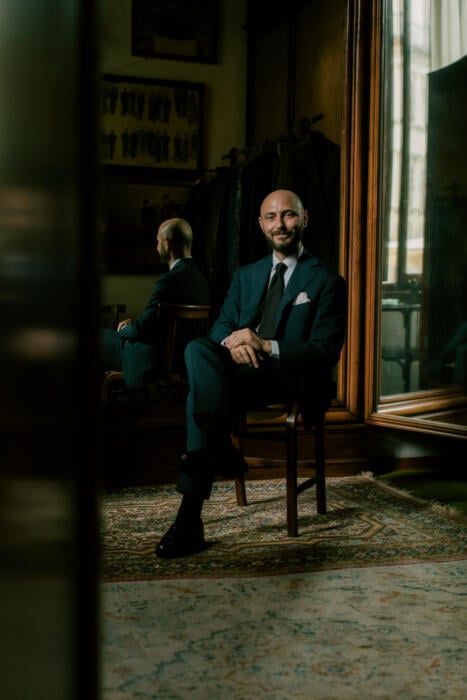Having met the Florentine tailor Vittorio Salino last summer, I took the opportunity of being in Florence this past January to commission a jacket. I got on with Vittorio, was impressed with his outlook, and realised PS readers would be interested in a Florentine option now that Liverano has become so expensive and Vestrucci is mostly MTM.
When I have that jacket I’ll do a full review, but for the moment I wanted to talk about Vittorio’s background, his work and how he sees the future of bespoke. We took some nice images of the fitting for the jacket too, in the new atelier Vittorio is setting up in a residential neighbourhood just north of the Fortezza.
That atelier was very much embryonic. The ground floor had one or two pieces of furniture, but was essentially a shell. Downstairs, there were cutting tables, steam irons and a mirror, but had little more in the way of outfitting.
The plan is to have the place fully kitted up by June, with a cosy seating area and big fitting room upstairs, as well as a bar.
For the moment, there’s a nice coffee bar on the corner of the street, and Vittorio and I chatted there, along with his assistant Clément, about questions of clothing and philosophy.
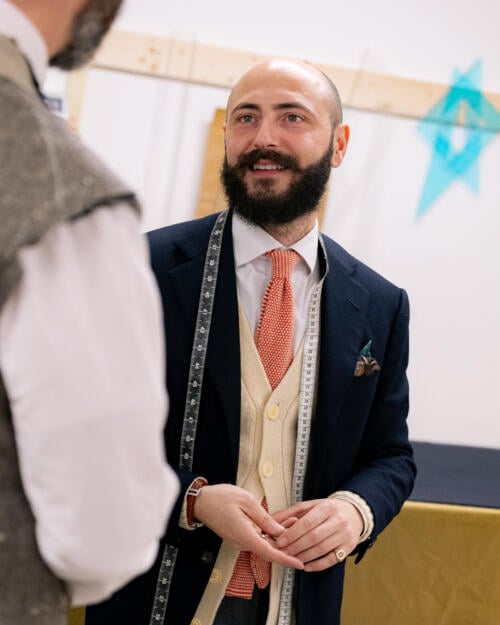
Where did you train before Liverano, Vittorio?e
Before I started my career at Liverano & Liverano I had three years of ‘school’ at the Camera Europe Dell’Alta Sartorial [CEDAS]. My teacher there was Luigi Gallo. The school was in the morning and then in the afternoon I had an apprenticeship in the tailor shop under him.
How long were you at Liverano?
After those three years of tailoring school, I had the opportunity to go to Liverano & Liverano. There I underwent the classic method of learning bespoke.
First you learn all the small, less important aspects: sotto di collo, basting lines… Then you go to the first fitting and the making of the sleeves. Then the second fitting. Finally, you learn how to finish everything else in a jacket: the sides, the shoulders, the collar.
The hardest part is arguably how to set the sleeves in the sleevehead, and to finish the shoulder. When I mastered all these steps, including pattern making and cutting, Antonio Liverano asked me to go to trunk shows with him around the world, where I went to Asia, America etc, and discovered the different styles and ways of thinking.
During Covid I also taught at the Liverano School for two years, where I had the opportunity to work with future tailors. Some off those went to Cifonelli, others had a chance to work at Liverano, and one became my assistant, Clément [below]. By the end I was doing all the above at the same time.
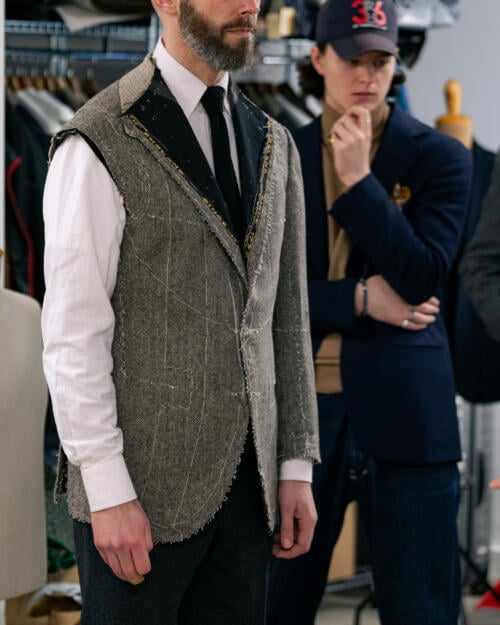
Why did you decide to leave and set up on your own?
I don’t really like to say it, but I felt undervalued at Liverano for the time and effort I had put in. I felt that I could do the same but for myself, and prove that I’m good at what I do. Not that I really had something to prove, but I wanted to feel free and show my own vision and philosophy.
How would you say your product or approach is different to Liverano?
Style-wise we are still perfecting our jacket style. But that’s inevitable – it’s always a never-ending journey – and the changes are never drastic. Fundamental views and philosophies don’t change.
For example, for us the most important principle is comfort. If you are not comfortable in your jacket or suit, you won’t wear it. You need to be able to go about your daily chores and almost forget you have a jacket on. We make it slightly larger in the chest as one way to create this feeling.
One of the most beautiful things is to dress someone who has imperfections, and to show it in the jacket. We think the jacket should never hide anything, but rather show it elegantly. That’s why it’s really important to have a soft jacket: no shoulder padding, no heavy canvas.
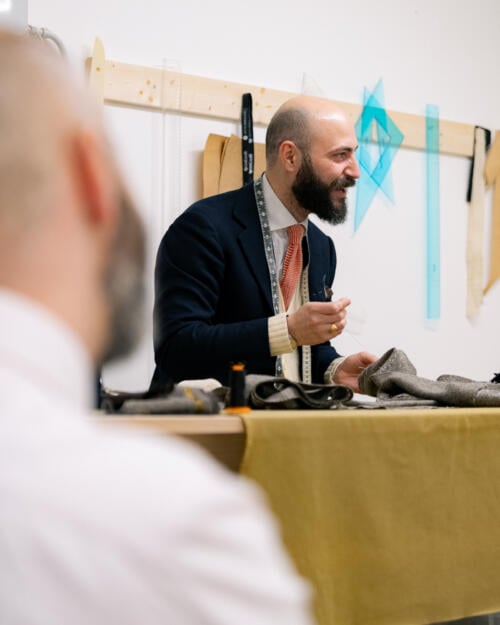
Technically how would you describe your cut?
My jacket style could be said to be influenced by the eighties Florentine jacket, rather than the modern one. Style influences would be Luigi Liverano and Vladimiro Mealli.
The jacket should be very tight around the neck and a bit more open in the front. The buttons sit a little lower than the classic Florentine (as a reference, perhaps 1cm lower than Liverano). The lapels are a bit wider so they can have a beautiful wave form over time, as they open up.
I make a straight chest pocket as the ‘boat’ form is created over time, with the help of a pocket square. We tend to give slightly more room in the hips for comfort and a slightly higher vent – level or slightly lower than the pocket. The shoulder is slightly extended but never exaggerated.
Our trousers are a bit larger in the front to be sure that the front darts stay closed. We heavily work on the calf as it’s a pet peeve of mine to see it break there. We prefer simple slant pockets, and the trouser should just hit the top of the shoe, with a minimal break.
We haven’t made a lot of coats yet, but style-wise I tend to go for raglans and single-breasted peak-lapels. They tend to have cleaner cuts, and simplicity. I don’t like to add martingales. I make the collar and sleeves slightly larger.
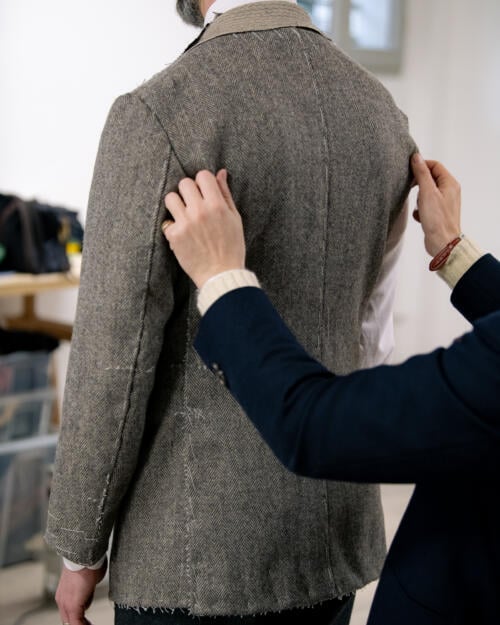
You seem to have a broader awareness of men’s clothing than some tailors, do you think that’s fair?
Perhaps yes. We like to experiment and love side projects. We’ve made bespoke clothes that are very different from classic tailoring, including ‘fashion’ garments for fashion schools, dresses and cultural/traditional garments.
My philosophy of trying to make something timeless that follows you in life comes from my travels, and love of vintage. I have pieces from the forties that are unworn. In this day and age it’s really hard to find clothes that are made in the same way.
Does that influence how you see the future of bespoke tailoring?
Yes. Bespoke needs to go in a new direction, and for me the important thing is ease – a bespoke piece should be treated like a normal jacket or even an overshirt. It shouldn’t be something you only wear at work or at very formal events.
Bespoke should be playful, and mixed with daily clothes like jeans, penny loafers, perhaps a jungle jacket over the top. Vintage military garments probably influence our colour palette as well: we tend to go with similar greens, browns and blues.
I want to make garments that you wear, break in, throw in the trunk of your car, and take for a long walk. They should be like a second skin and show that they’ve lived – I love to see defects from wear and tear. We hope that after two generations, a jacket will have been repaired, altered, and still used. We can alter it for those generations as it always has at least four sizes of inlay inside.
For more on Vittorio (and some old images!) see his interview with The Armoury here.
A review of the finished jacket, made in Fox Tweed TD9, will follow in a couple of weeks. The jacket pictured is at a first-fitting stage.
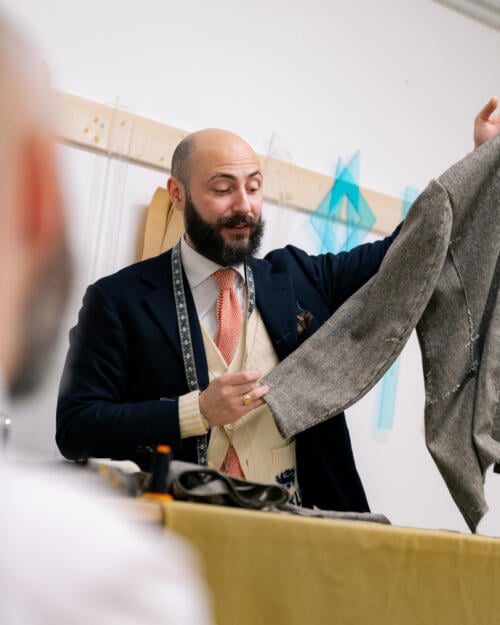
Vittorio Salino’s prices in Florence start at:
- Jacket: €2200
- Suit: €3000
- Trousers: €800
- Coat: €4500
All prices include cloth and tax. Trunk show prices vary
Those trunk shows are held in Belgium, Zurich and Los Angeles. There are no plans to add others in the near future, due to capacity (Vittorio and Clément make everything themselves.)
Upcoming dates:
- 29th-30th March: Antwerp and Brussels
- 26th-28th April: Zurich
- 20th-25th May: Los Angeles
